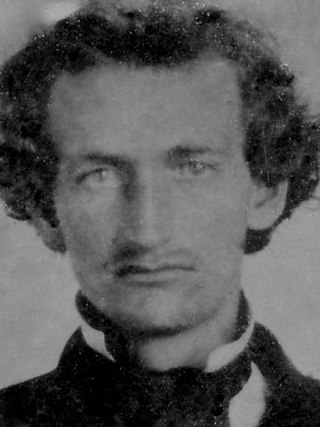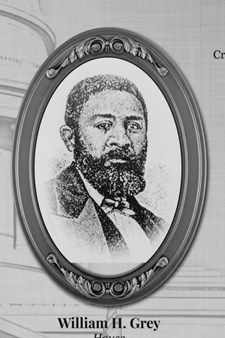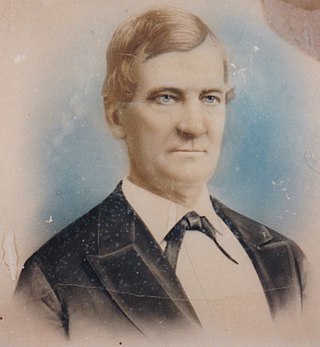Related Research Articles

A constituent assembly is a body assembled for the purpose of drafting or revising a constitution. Members of a constituent assembly may be elected by popular vote, drawn by sortition, appointed, or some combination of these methods. Assemblies are typically considered distinct from a regular legislature, although members of the legislature may compose a significant number or all of its members. As the fundamental document constituting a state, a constitution cannot normally be modified or amended by the state's normal legislative procedures in some jurisdictions; instead a constitutional convention or a constituent assembly, the rules for which are normally laid down in the constitution, must be set up. A constituent assembly is usually set up for its specific purpose, which it carries out in a relatively short time, after which the assembly is dissolved. A constituent assembly is a form of representative democracy.

The Brooks–Baxter War, also known as the Brooks–Baxter Affair, was an attempt made by failed gubernatorial candidate Joseph Brooks of the “Brindle-tail” faction of Arkansas' Republican Party to take control of the state from Elisha Baxter, who was the Republican governor. The victor in the end was the Baxter administration, also known as the "Minstrels", supported by "carpetbaggers" over the Brindle-tails supported by "scalawags" and "freedmen".

The Old State House, formerly called the Arkansas State House, is the oldest surviving state capitol building west of the Mississippi River. It was the site of the secession convention, as well as the fourth constitutional convention when delegates agreed to ensure voting rights for freedmen and establish public education.

Augustus Hill Garland was an American lawyer and Democratic politician from Arkansas, who initially opposed Arkansas' secession from the United States, but later served in both houses of the Congress of the Confederate States and the United States Senate, as well as becoming the 11th governor of Arkansas (1874–1877) and the 38th attorney general of the United States (1885–1889). He wrote several books.
The Constitution of Arkansas is the primary organizing law for the U.S. state of Arkansas delineating the duties, powers, structures, and functions of the state government. Arkansas' original constitution was adopted at a constitutional convention held at Little Rock in advance of the territory's admission to the Union in 1836. In 1861 a constitution was adopted with succession. After the American Civil War its 1864 constitution was drafted.An 1868 constitution was passed to comply with the Reconstruction acts. The current constitution was ratified in 1874 following the Brooks–Baxter War.

The Virginia Conventions have been the assemblies of delegates elected for the purpose of establishing constitutions of fundamental law for the Commonwealth of Virginia superior to General Assembly legislation. Their constitutions and subsequent amendments span four centuries across the territory of modern-day Virginia, West Virginia and Kentucky.
More than 1,500 African American officeholders served during the Reconstruction era (1865–1877) and in the years after Reconstruction before white supremacy, disenfranchisement, and the Democratic Party fully reasserted control in Southern states. Historian Canter Brown Jr. noted that in some states, such as Florida, the highest number of African Americans were elected or appointed to offices after the end of Reconstruction in 1877. The following is a partial list of notable African American officeholders from the end of the Civil War until before 1900. Dates listed are the year that a term states or the range of years served if multiple terms.

James M. Hinds was the first U.S. Congressman assassinated in office. He served as member of the United States House of Representatives for Arkansas from June 24, 1868 until his assassination by the Ku Klux Klan. Hinds, who was white, was an advocate of civil rights for black former slaves during the Reconstruction era following the American Civil War.

During the American Civil War, Arkansas was a Confederate state, though it had initially voted to remain in the Union. Following the capture of Fort Sumter in April 1861, Abraham Lincoln called for troops from every Union state to put down the rebellion, and Arkansas and several other states seceded. For the rest of the civil war, Arkansas played a major role in controlling the Mississippi River, a major waterway.

The Virginia Constitutional Convention of 1868, was an assembly of delegates elected by the voters to establish the fundamental law of Virginia following the American Civil War and the Fourteenth Amendment to the US Constitution. The Convention, which met from December 3, 1867 until April 17, 1868, set the stage for enfranchising freedmen, Virginia's readmission to Congress and an end to Congressional Reconstruction.

James T. White was a Baptist minister and state legislator from Helena and Little Rock, Arkansas. He was a member of the Arkansas House of Representatives and later the Arkansas Senate in the late 1860s and early 1870s. He was also a member of the Arkansas constitutional conventions in 1868 and 1874. He edited the Baptist newspaper, The Arkansas Review. He was an African American and a Republican. In 1868 he was among the first six African Americans to serve in the Arkansas House.

William Henry Grey was a state legislator, storeowner and church leader in Arkansas. He served in various elected and public offices in the state during the Reconstruction era. The Encyclopedia of Arkansas calls Grey "a tireless fighter for the rights of freedmen." In 1868 he was among the first six African Americans who served in the Arkansas House. His gravesite in Magnolia Cemetery was listed on the National Register of Historic Places in 2019.

Women's suffrage had early champions among men in Arkansas. Miles Ledford Langley of Arkadelphia, Arkansas proposed a women's suffrage clause during the 1868 Arkansas Constitutional Convention. Educator, James Mitchell wanted to see a world where his daughters had equal rights. The first woman's suffrage group in Arkansas was organized by Lizzie Dorman Fyler in 1881. A second women's suffrage organization was formed by Clara McDiarmid in 1888. McDiarmid was very influential on women's suffrage work in the last few decades of the nineteenth century. When she died in 1899, suffrage work slowed down, but did not all-together end. Both Bernie Babcock and Jean Vernor Jennings continued to work behind the scenes. In the 1910s, women's suffrage work began to increase again. socialist women, like Freda Hogan were very involved in women's suffrage causes. Other social activists, like Minnie Rutherford Fuller became involved in the Political Equality League (PEL) founded in 1911 by Jennings. Another statewide suffrage group, also known as the Arkansas Woman Suffrage Association (AWSA) was organized in 1914. AWSA decided to work towards helping women vote in the important primary elections in the state. The first woman to address the Arkansas General Assembly was suffragist Florence Brown Cotnam who spoke in favor of a women's suffrage amendment on February 5, 1915. While that amendment was not completely successful, Cotnam was able to persuade the Arkansas governor to hold a special legislative session in 1917. That year Arkansas women won the right to vote in primary elections. In May 1918, between 40,000 and 50,000 white women voted in the primaries. African American voters were restricted from voting in primaries in the state. Further efforts to amend the state constitution took place in 1918, but were also unsuccessful. When the Nineteenth Amendment passed the United States Congress, Arkansas held another special legislative session in July 1919. The amendment was ratified on July 28 and Arkansas became the twelfth state to ratify the Nineteenth Amendment.

Jesse Jackson Millsaps was an officer in the Union Army during the American Civil War, a farmer, and a state legislator who served in the Arkansas House of Representatives representing Van Buren County, Arkansas in 1868 and 1885.
Anderson Louis Rush was a state legislator in Arkansas. He represented Pulaski County in the Arkansas House of Representatives in 1868 and 1869. He was a Republican. He was one of the six African Americans who first served in the Arkansas House. He represented the 10th District.
Richard R. Samuels was a farmer, blacksmith and state legislator in Arkansas. He was a delegate to the 1868 Arkansas Constitutional Convention from Hempstead County, Arkansas. He was one of 8 African American delegates at the convention. He represented Hempstead County, Arkansas in the Arkansas House of Representatives in 1868 and 1869. He was a Republican. He was one of the first six African Americans to serve in the Arkansas Legislature. At The Brindle Convention in 1872 he was nominated for the position of superintendent of the penitentiary. He also served on the grand jury for a fraud and corruption trial in Hempstead.

William L. Owen was a prominent planter, businessman, and politician from Halifax County, Virginia. As a politician, he served in the House of Delegates of Virginia, the Committee of Nine, and the Virginia Constitutional Convention of 1867. He was a trustee of Virginia Military Institute and Hampden-Sydney College.
W. T. J. Hayes, sometimes documented as H. T. J. Hayes, was a public official and state legislator in North Carolina. He served in the North Carolina House of Representatives in 1868 for Halifax County, North Carolina. He was a signatory of North Carolina's 1868 Constitution. He was a Republican.
John G. Marler was a state legislator in North Carolina. He served two terms in the North Carolina House of Representatives and then served in the North Carolina Senate.
John Newton Sarber was a Republican politician and a U.S. Marshal in Arkansas during the Reconstruction era. He was a member of Arkansas's 1868 Constitutional Convention and served in the Arkansas General Assembly. Sarber was a leader in legislation establishing Arkansas's public school system, the Arkansas Industrial University, and what became Logan County, Arkansas, which was initially named Sarber County over his objections. When unreconstructed Democrats returned to power, they applied political pressure to Sarber and other carpetbaggers. Sarber resigned from the marshals and Sarber County was renamed for James Logan.
References
- ↑ Convention, 1868, Arkansas Constitutional (November 29, 1868). "Debates and Proceedings of the Convention which Assembled at Little Rock, January 7th, 1868 ...: To Form a Constitution for the State of Arkansas". J. G. Price, printer to the convention – via Google Books.
{{cite web}}: CS1 maint: numeric names: authors list (link) - ↑ Debates and Proceedings of the Convention which Assembled at Little Rock, January 7th, 1868 ...: To Form a Constitution for the State of Arkansas. J. G. Price, printer to the convention. 1868.
- ↑ "Encyclopedia of Arkansas". Encyclopedia of Arkansas.
- ↑ Branam, Christopher Warren (May 2011). The Africans Have Taken Arkansas: Political Activities of African-American Members of the Arkansas Legislature, 1868-73 (Thesis). University of Arkansas.